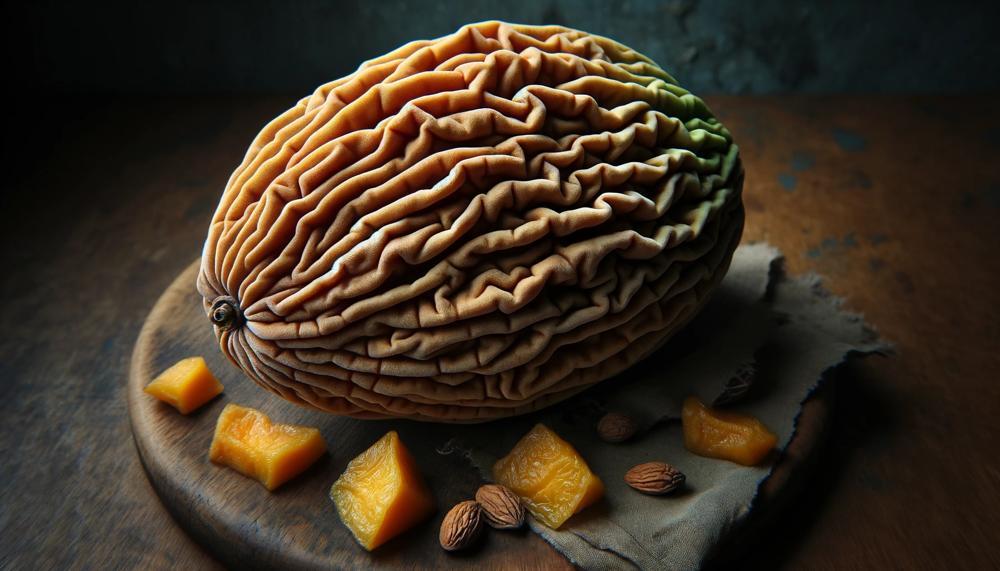To determine whether a wrinkled mango is bad or not, you can rely on various cues.
Fresh mangos have a firm texture, while those that are starting to go bad may develop soft spots. Brown marks or mold on a mango and an unpleasant smell are also signs of spoilage.
Additionally, as mangos age, their skin may wrinkle. The color of the fruit does not indicate its ripeness.
The shelf life of mangos varies depending on storage conditions, with refrigerated mangos lasting up to five to seven days, while those kept at room temperature generally last for two to three days.
Contents
Key Takeaways:
- Wrinkled mangos may be a sign that the fruit is starting to spoil.
- Soft spots, brown marks, and mold are indications of a bad mango.
- The color of a mango does not determine its ripeness or quality.
- Refrigerating mangos can extend their shelf life.
Signs of a Bad Mango
When it comes to identifying a bad mango, there are a few key signs to look out for.
- Wrinkled skin: If a mango is completely covered with deep wrinkles, it is a clear indication of spoilage.
- Black spots: Black spots that penetrate the skin and emit liquid are a definite sign of a bad mango.
- Super soft texture: When a mango feels excessively soft to the touch, it is likely overripe and on its way to spoilage.
- Mold: The presence of mold on a mango is a sure sign that it has gone bad.
- Boozy smell: A strong, unpleasant smell near the stem area, reminiscent of alcohol, indicates spoilage.
- Mushy or dark flesh: A good mango should have firm, juicy flesh. If it feels mushy or appears discolored, it is best to discard it.
By paying attention to these signs, you can easily determine whether a mango is bad and should not be consumed. It’s important to remember that a bad mango may pose health risks if consumed, so it’s always better to be safe than sorry.
How To Tell If A Wrinkled Mango Is Bad?
Here are some ways to tell if a mango has gone bad:
Wrinkles
A mango that is overripe will have deep wrinkles. However, if a mango is wrinkled but green, it means it was harvested immature.
Texture
A fresh mango is firm, while a mango that is starting to go bad may have soft spots. If you cut into an overripe mango, the flesh will be brownish in spots.
Appearance
Other signs that a mango has gone bad include:
- Brown marks
- Mold
- White spots on the inside flesh
Smell
An overripe mango may smell unpleasant.
Taste
A healthy mango should not taste fizzy. If the mango smells and tastes off, it might have gotten bruised during transportation or it got squashed by something else.
What Color Is a Bad Mango?

While the color of a mango can provide some indication of its ripeness, it is not the sole indicator of whether a mango is bad or not. Different mango varieties have different colors when ripe.
Generally, a bad mango will have extremely dull colors, with the yellow turning dark mustard, the green turning gray, and the red becoming deep brown. The flesh of a bad mango will also turn brown, indicating spoilage.
It’s important to note that the color changes in a bad mango are not a reliable way to determine its ripeness. Even a perfectly ripe mango can have varying colors depending on the variety.
To accurately assess the ripeness, it is essential to look for other signs such as texture, smell, and overall appearance.
Here is a quick reference table that summarizes the color changes in a bad mango:
| Color | Indication of Spoilage |
|---|---|
| Yellow | Turns dark mustard |
| Green | Turns gray |
| Red | Becomes deep brown |
It’s essential to visually inspect the mango’s color and compare it to the usual appearance of ripe mangoes. Remember, the color alone should never be the sole determining factor when identifying a bad mango.
Can You Eat Wrinkled Mangoes
Wrinkles on mangoes can be a natural occurrence as the fruit ripens. If the wrinkles are superficial, the mango can still be eaten. However, if the mango has a lot of deep wrinkles, it is likely already rotting on the inside.
To determine if a wrinkled mango is still edible, it is best to cut it open and check the inside for any signs of spoilage.
If you’re unsure if a wrinkled mango is still good to eat, here’s a simple guide:
- Inspect the wrinkles: Superficial wrinkles are normal and indicate ripeness, whereas deep wrinkles or shriveling can signal rotting.
- Check the firmness: Press gently on the mango. If it’s still firm, it’s likely safe to eat. Mushy or overly soft mangoes are past their prime.
- Slice it open: If you’re uncertain about the mango’s quality, cut it open. Look for any signs of mold, dark spots, or off smells. If you spot any of these, discard the fruit.
Remember, it’s always better to be safe than sorry when it comes to consuming wrinkled mangoes. If in doubt, trust your senses and opt for a fresh, ripe mango instead.
| Wrinkled Mango | Eating Recommendation |
|---|---|
| Superficial wrinkles | Safe to eat |
| Deep wrinkles or shriveling | Potentially rotting, best to discard |
| Mold, dark spots, or off smells | Discard immediately |
What Does a Bad Mango Taste Like?
A bad mango will taste bitter, pungent, and boozy. When a mango starts to spoil, the high sugar content in the fruit causes enzymes to ferment it naturally, resulting in an unpleasant taste. If a mango has a sour or off-putting smell, it is a clear indication that fermentation has begun. It is not recommended to consume a mango that tastes bad or has a fermented odor.
Conclusion
In conclusion, determining whether a wrinkled mango is bad involves observing various cues. Signs of a bad mango include wrinkled skin, black spots that penetrate the skin, super soft texture, mold, and a boozy smell.
The color of the mango can also indicate spoilage, with extremely dull colors being a bad sign. If a mango tastes bitter, pungent, or boozy, it is best to discard it.
Properly storing mangoes is crucial to ensuring their freshness and quality. Refrigeration can prolong the shelf life of mangoes, while maintaining a firm texture. Remember to promptly consume or use the mangoes before they begin to show signs of spoilage.
By following these guidelines, you can confidently enjoy delicious and nutritious mangoes without the worry of consuming a bad fruit.
To summarize, when assessing a mango’s quality, look out for the signs of spoilage mentioned earlier. Observe the texture, color, aroma, and taste to determine if the mango is fit for consumption.
By being vigilant and knowledgeable about the signs of a bad mango, you can ensure a delightful culinary experience every time you indulge in this tropical fruit.




